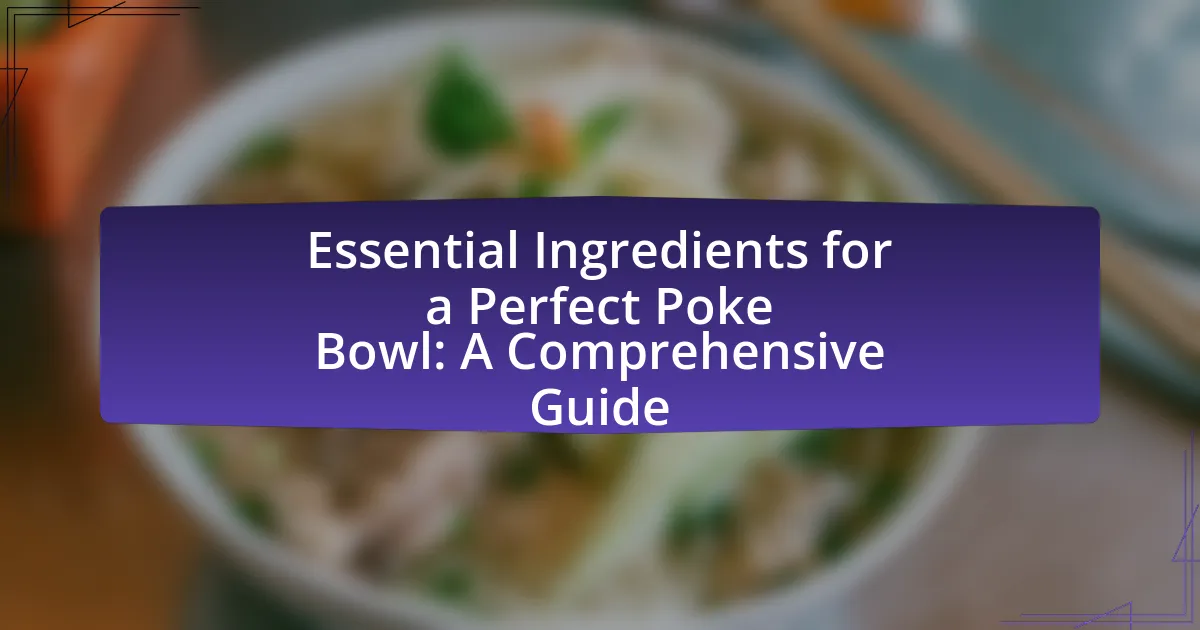The article provides a comprehensive guide to the essential ingredients for creating a perfect poke bowl, emphasizing the importance of high-quality, fresh components. Key ingredients include sushi-grade fish, such as tuna and salmon, short-grain sushi rice, a variety of vegetables, and flavorful sauces. The article explores how these ingredients contribute to the overall flavor, texture, and nutritional profile of the dish, while also discussing customization options, best practices for preparation, and common mistakes to avoid. Additionally, it highlights the significance of presentation and ingredient arrangement in enhancing the dining experience.

What are the Essential Ingredients for a Perfect Poke Bowl?
The essential ingredients for a perfect poke bowl include sushi-grade fish, rice, vegetables, and sauces. Sushi-grade fish, such as tuna or salmon, serves as the protein base, while short-grain sushi rice provides the necessary texture and flavor. Fresh vegetables like cucumber, avocado, and radish add crunch and nutrition. Additionally, sauces such as soy sauce, sesame oil, or spicy mayo enhance the overall taste. These components are fundamental to achieving the authentic poke bowl experience, which originates from Hawaiian cuisine, where fresh, high-quality ingredients are prioritized.
How do the base ingredients contribute to a poke bowl’s flavor?
The base ingredients of a poke bowl, primarily rice or salad greens, significantly contribute to its flavor by providing a neutral foundation that balances the dish’s more intense toppings. The rice, often seasoned with vinegar, adds a subtle tanginess and a chewy texture, while salad greens offer a fresh, crisp contrast. This combination allows the flavors of marinated fish, vegetables, and sauces to shine without overwhelming the palate. For instance, sushi rice, commonly used in poke bowls, has a slightly sweet and savory profile that complements the umami of the fish, enhancing the overall taste experience.
What types of rice are commonly used in poke bowls?
Sushi rice and brown rice are commonly used in poke bowls. Sushi rice, also known as shari, is a short-grain rice that becomes sticky when cooked, making it ideal for holding together in a bowl. Brown rice, a whole grain option, offers a nuttier flavor and more fiber, appealing to health-conscious diners. Both types of rice provide a solid base for the fresh ingredients typically found in poke bowls, such as fish, vegetables, and sauces.
How does the choice of base affect the overall dish?
The choice of base significantly influences the overall dish by determining the flavor, texture, and nutritional profile of the poke bowl. For instance, rice serves as a traditional base, providing a neutral flavor that complements the fish and toppings, while also offering carbohydrates for energy. In contrast, alternatives like quinoa or mixed greens introduce distinct flavors and textures, enhancing the dish’s complexity and nutritional value. Research indicates that the base can account for up to 30% of the dish’s overall flavor profile, emphasizing its critical role in achieving a balanced and satisfying meal.
What proteins are typically included in a poke bowl?
Poke bowls typically include proteins such as raw fish, tofu, and cooked seafood. Common choices for raw fish are tuna, salmon, and octopus, which provide essential omega-3 fatty acids and high-quality protein. Tofu serves as a plant-based protein option, appealing to vegetarians and vegans. Cooked seafood options may include shrimp or crab, offering additional variety and flavor. These proteins are fundamental to the poke bowl’s nutritional profile and overall appeal.
What are the most popular fish options for poke bowls?
The most popular fish options for poke bowls include tuna, salmon, and yellowtail. Tuna is often favored for its rich flavor and firm texture, making it a staple in traditional poke. Salmon is also widely used due to its buttery taste and high omega-3 fatty acid content, which adds nutritional value. Yellowtail, known for its mild flavor and tender flesh, is another common choice that complements various toppings and sauces. These fish options are frequently selected for their taste, texture, and nutritional benefits, making them essential ingredients in poke bowls.
How do vegetarian and vegan proteins compare in poke bowls?
Vegetarian and vegan proteins in poke bowls differ primarily in their sources and nutritional profiles. Vegetarian proteins, such as eggs and dairy products like cheese, provide complete proteins containing all essential amino acids, while vegan proteins, derived from plants like tofu, tempeh, and legumes, may lack one or more essential amino acids but can be combined to achieve a complete protein profile. For instance, tofu offers about 8 grams of protein per 100 grams, while chickpeas provide around 9 grams per 100 grams, making both viable options for protein in poke bowls. However, combining different vegan sources, such as quinoa and black beans, can enhance the overall amino acid profile, ensuring a balanced intake.
What role do toppings play in enhancing a poke bowl?
Toppings play a crucial role in enhancing a poke bowl by adding texture, flavor, and visual appeal. They provide a contrast to the base ingredients, such as rice and fish, enriching the overall eating experience. For instance, crunchy toppings like seaweed salad or crispy onions introduce a satisfying crunch, while creamy elements like avocado or spicy mayo contribute richness. Additionally, toppings such as sesame seeds or scallions not only enhance flavor but also add a pop of color, making the dish more visually appealing. This combination of textures and flavors is essential for creating a balanced and enjoyable poke bowl.
Which vegetables are essential for a balanced poke bowl?
Cucumbers, radishes, seaweed, and avocado are essential vegetables for a balanced poke bowl. Cucumbers provide hydration and crunch, while radishes add a peppery flavor and crunch. Seaweed contributes umami and essential nutrients, and avocado offers healthy fats and creaminess. These vegetables collectively enhance the nutritional profile and flavor balance of a poke bowl, making them integral components.
How do sauces and seasonings elevate the dish?
Sauces and seasonings elevate a dish by enhancing its flavor profile and adding complexity. They introduce various taste elements such as sweetness, acidity, umami, and spiciness, which can transform a simple ingredient into a gourmet experience. For example, a soy sauce-based dressing can provide a savory depth that complements the freshness of fish in a poke bowl, while sesame oil adds a nutty aroma. Studies show that the right combination of sauces and seasonings can increase overall satisfaction and enjoyment of a meal, as they stimulate the palate and create a more balanced taste experience.

How can you customize your poke bowl?
You can customize your poke bowl by selecting a base, protein, toppings, sauces, and garnishes. The base can include options like sushi rice, brown rice, or mixed greens, while the protein choices typically feature raw fish such as tuna or salmon, or alternatives like tofu or chicken. Toppings can range from seaweed salad and avocado to edamame and cucumber, allowing for a variety of textures and flavors. Sauces, such as soy sauce, spicy mayo, or ponzu, enhance the overall taste, and garnishes like sesame seeds or green onions add finishing touches. This customization process allows for a personalized meal that caters to individual preferences and dietary needs.
What are some creative ingredient combinations for poke bowls?
Creative ingredient combinations for poke bowls include marinated tuna with avocado and mango, salmon with cucumber and seaweed salad, and tofu with edamame and pickled ginger. These combinations enhance flavor and texture, making the dish more appealing. For instance, the sweetness of mango complements the savory tuna, while the crunch of cucumber adds freshness to the salmon. Additionally, tofu paired with edamame provides a protein-rich vegetarian option, showcasing the versatility of poke bowls.
How can you incorporate seasonal ingredients into your poke bowl?
To incorporate seasonal ingredients into your poke bowl, select fresh produce that is currently in season, such as avocados in spring or squash in fall. Seasonal ingredients enhance flavor and nutritional value, as they are harvested at their peak ripeness. For example, using locally sourced tomatoes in summer can provide a sweeter taste and higher nutrient content compared to out-of-season varieties. Additionally, incorporating seasonal fish, like salmon in summer, ensures freshness and supports sustainable fishing practices. This approach not only elevates the dish but also promotes local agriculture and reduces carbon footprint associated with transportation.
What unique toppings can add flair to your poke bowl?
Unique toppings that can add flair to your poke bowl include crispy shallots, furikake seasoning, and pickled ginger. Crispy shallots provide a crunchy texture and rich flavor, while furikake seasoning, a Japanese condiment made from seaweed and sesame seeds, enhances umami taste. Pickled ginger adds a tangy contrast that complements the freshness of the fish. These toppings not only elevate the visual appeal but also contribute diverse flavors and textures, making the poke bowl more enjoyable.
Why is presentation important in a poke bowl?
Presentation is important in a poke bowl because it enhances the visual appeal and overall dining experience. A well-presented poke bowl attracts attention, stimulates appetite, and reflects the quality of the ingredients used. Research indicates that visual aesthetics can significantly influence food perception and enjoyment, with studies showing that people often associate beautifully arranged dishes with better taste and freshness. Therefore, the careful arrangement of ingredients in a poke bowl not only makes it more enticing but also elevates the perception of the meal’s quality.
What techniques can enhance the visual appeal of your poke bowl?
To enhance the visual appeal of your poke bowl, utilize techniques such as vibrant ingredient selection, strategic layering, and garnishing. Vibrant ingredients like colorful vegetables, fresh fish, and bright toppings create an eye-catching presentation. Strategic layering involves arranging ingredients in a way that showcases their colors and textures, making the bowl visually dynamic. Garnishing with elements like sesame seeds, microgreens, or edible flowers adds finishing touches that elevate the overall aesthetic. Research indicates that visually appealing food can enhance the dining experience, as studies show that presentation significantly influences perceived taste and enjoyment.
How does the arrangement of ingredients affect the dining experience?
The arrangement of ingredients significantly enhances the dining experience by influencing visual appeal, flavor balance, and texture contrast. A well-structured presentation of a poke bowl, for instance, allows diners to appreciate the vibrant colors and freshness of each ingredient, which can stimulate appetite and enjoyment. Research indicates that visually appealing food can increase perceived taste satisfaction, as seen in studies published in the journal “Appetite,” where participants rated dishes higher when they were artfully arranged. Additionally, the strategic placement of ingredients can create a harmonious blend of flavors and textures, ensuring that each bite offers a balanced experience, which is crucial in dishes like poke bowls that combine various elements such as fish, vegetables, and sauces.

What are the best practices for preparing a poke bowl?
The best practices for preparing a poke bowl include selecting high-quality, fresh ingredients, balancing flavors and textures, and ensuring proper food safety. High-quality fish, such as sushi-grade tuna or salmon, should be used to guarantee freshness and safety. Balancing flavors involves combining savory, sweet, and umami elements, often achieved through marinades like soy sauce or sesame oil. Textural contrast can be created by incorporating crunchy vegetables, creamy avocado, and chewy rice. Food safety practices, such as keeping fish at the correct temperature and using clean utensils, are essential to prevent contamination. These practices ensure a delicious and safe poke bowl experience.
How do you ensure freshness in your poke bowl ingredients?
To ensure freshness in poke bowl ingredients, sourcing high-quality, local produce and seafood is essential. This practice minimizes the time between harvest or catch and consumption, maintaining optimal flavor and nutritional value. For instance, using fish caught within 24 hours significantly reduces spoilage risks and enhances taste. Additionally, proper storage techniques, such as refrigeration at appropriate temperatures, further preserve ingredient quality. Regular inventory checks help to rotate stock, ensuring that older items are used first, thus preventing waste and maintaining freshness.
What storage tips help maintain ingredient quality?
To maintain ingredient quality, store items in airtight containers to prevent moisture and air exposure. This method preserves freshness and prevents spoilage, as studies show that exposure to air can lead to oxidation, which degrades flavor and nutritional value. Additionally, refrigerate perishable ingredients promptly, as keeping them at room temperature can accelerate spoilage; for example, fish should be stored at temperatures below 40°F to maintain its quality and safety. Lastly, label containers with dates to ensure ingredients are used within their optimal timeframe, reducing waste and ensuring quality.
How can you safely prepare raw fish for your poke bowl?
To safely prepare raw fish for your poke bowl, start by sourcing high-quality fish that is labeled as sushi-grade, ensuring it is safe for raw consumption. Next, keep the fish refrigerated at temperatures below 40°F (4°C) until you are ready to prepare it, minimizing the risk of bacterial growth. Use a clean cutting board and sharp knife to cut the fish into bite-sized cubes, and always wash your hands and utensils before and after handling the fish to prevent cross-contamination. According to the U.S. Food and Drug Administration (FDA), freezing fish at -4°F (-20°C) for at least seven days can kill parasites, further ensuring safety when consuming raw fish.
What common mistakes should you avoid when making a poke bowl?
Common mistakes to avoid when making a poke bowl include using low-quality fish, neglecting to marinate the fish properly, and overloading on toppings. Low-quality fish can lead to food safety issues and an unappealing taste, as fresh, high-quality fish is essential for a good poke bowl. Proper marination enhances flavor; skipping this step results in bland fish. Overloading on toppings can overwhelm the dish, making it difficult to enjoy the distinct flavors of each ingredient. Balancing the components is crucial for a harmonious poke bowl experience.
How can over-seasoning affect the flavor of your poke bowl?
Over-seasoning can overwhelm the delicate flavors of a poke bowl, leading to an unbalanced taste profile. When excessive amounts of soy sauce, sesame oil, or other seasonings are used, they can mask the natural flavors of the fish and fresh ingredients, resulting in a dish that tastes overly salty or rich. This imbalance can detract from the intended freshness and harmony that a well-prepared poke bowl should offer, as the primary ingredients like fish, vegetables, and rice are meant to complement each other rather than be dominated by strong seasonings.
What are the pitfalls of ingredient combinations to watch out for?
The pitfalls of ingredient combinations in poke bowls include flavor clashes, textural inconsistencies, and nutritional imbalances. For instance, combining overly sweet ingredients like mango with strong savory elements such as soy sauce can create an unbalanced flavor profile. Additionally, mixing crunchy toppings like fried onions with soft ingredients like avocado may lead to an unsatisfactory texture experience. Nutritionally, pairing high-calorie ingredients, such as creamy sauces, with other calorie-dense items can result in an excessively rich dish, undermining health goals. These pitfalls highlight the importance of thoughtful ingredient selection to achieve a harmonious poke bowl.
What tips can help you create the perfect poke bowl at home?
To create the perfect poke bowl at home, focus on using high-quality, fresh ingredients. Start with sushi-grade fish, such as tuna or salmon, ensuring it is sourced from reputable suppliers to guarantee safety and flavor. Incorporate a base of sushi rice, seasoned with rice vinegar, sugar, and salt, which enhances the overall taste. Add a variety of toppings like avocado, seaweed salad, and pickled vegetables to provide texture and flavor contrast. Drizzle with a flavorful sauce, such as soy sauce or spicy mayo, to elevate the dish. Finally, garnish with sesame seeds or green onions for added visual appeal and taste. These tips ensure a balanced and delicious poke bowl that reflects authentic flavors.



